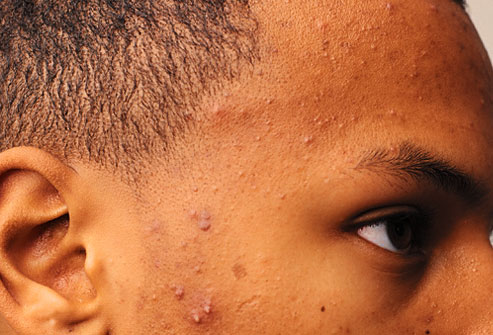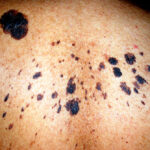A common challenge faced by women with rich complexion is acne. Acne vulgaris which hinders the dream of a perfect and clear skin, is often accompanied by facial hyperpigmentation – dark spots and patches appear all over the face. Where acne is dismissed or left untreated, it results in a near permanent discoloration or scarring of the skin. Needless to say, acne vulgaris often results in social embarrassment and frustration. But it can be treated – the dream of a perfect brown skin is achievable with the right steps.
Knowledge is fundamental to solving problems. In the same vein, it is important to understand all there is to know about acne vulgaris, before one can figure out how to treat it. To do this, let’s begin with the hair follicle. Each hair follicle is lined with cells containing sebaceous glands (these produce the oil known as sebum). Naturally, the cells lining the follicle are shed periodically – they’re raised to the surface of the skin by the sebum and summarily washed away when bathing. But, in cases where the cells coagulate instead of shedding, they cause an obstruction in pore of the skin. Where a pore is clogged, a sac known as microcomedone is form – it contains oil and dead cells. Here, bacteria (Propionibacterium acnes) start to grow – feeding on the dead cells and oil in the microcomedone. The more the sac grows, the more it sprouts either whiteheads (closed comedone) or blackheads (open comedone).
A handful of factors aid the growth of acne in rich complexion women. Factors such as stress, inherited traits and diet, all contribute to acne development. At times, frequent heavy makeup also contributes to the growth of acne in brown skinned women. There is also an acne known as “pomade acne”, and is caused by certain hair oil and pomades used by brown skinned women.
Acne oftentimes appears on the face, but could also be found on the shoulders, back and chest region. Depending on their nature, acnes are divided into four, namely;
- Comedones which could either be whiteheads or blackheads.
- Papules which are either small or big sized bumps of red or dark brown color.
- Pustules are bumps of varying sizes filled with pus.
- Cyst and Nodules which are mostly large and painful bumps filled with pus.
Does Diet Affect Acne?
Although it is yet uncertain if diet is a direct cause of acne, but a few researchers speculate that certain Western foods aid the growth of acne. According to a study of Western and non-Western populations and their diet, the non-Westerners (Kitavan Islanders of Papua Guinea and the Ache Hunting/Gathering Tribe of Paraguay) had no cases of acne, unlike the Westerners (Americans). The difference came from the diet of each group, with the non-Westerners feeding mostly on fruits, fish, tubers and wild game, while the Westerners consumed more of carbohydrates and sugar in varying forms.
According to researchers, the continued consumption of carbohydrates and sugar in Western diet, aided the production of insulin and other hormones that conversely augment the production of oil by the sebaceous gland. This oil in turn, accumulates and causes acne.
Based on further studies, it turned out that sugar-based foods were factors in the growth of acne, while salt-based foods such as fries, pizza and the likes did not show much link with acne. In all, a balanced diet comprising mostly of fruits, vegetables and protein, would reduce the risk of acne.
Treatment
To get treated for acne, it is important to reduce the causative bacteria and accumulated oil. The clogged hair follicles have to be unclogged by removing the sac of oil. For women with brown skin, hyperpigmentation must be treated likewise to cure acne.
While there is no cure for acne, there are a handful of medications to consider when treating acne. These medications include;
1. Topical Antimicrobials: products with antimicrobial and comedolytic agents such as topical benzoyl peroxide, can be used to treat acne. Particularly topical benzoyl peroxide has been used over the years to treat acne, and it has shown great effectiveness against bacteria and comedones. It is available in gels, lotions, creams and the likes in varying concentrations. To choose a benzoyl peroxide product, you’ll need to factor in your skin type and your personal preference. If your skin is mostly dry, then you’ll need a cream or lotion-based benzoyl peroxide product. Or you could use a gel-based benzoyl peroxide product for an oily skin.
Benzoyl peroxide comes with a few side effects, hence to get the best results and manage the side effects, it would be best if you consult your dermatologist and stick to a prescription.
2. Topical Antibiotics: these aid in reducing acne-based inflammation of the skin. Topical antibiotics can be applied twice daily for a maximum period of 8 weeks before any changes would be noticed. Antibiotics come in form of gels, creams, pads, foams and the likes, and are to be chosen based on your personal preference and skin type. Side effects such as skin irritation and dryness may be experienced, hence avoid using topical antibiotics without learn prescription from your dermatologist.
3. Oral Antibiotics: these are relatively more efficient than the topical antibiotics. As it has been stated earlier that there is no cure for acne, oral antibiotics only manage acne symptoms by killing off the causative bacteria and reducing inflammation.
Just like topical antibiotics, oral antibiotics are generally to be taken twice daily, but there are newer versions that only require a single dose per day. Notable side effects include, dizziness, stomach upset, sun sensitivity, headache, rashes among others. But these side effects can be mitigated with other forms of medication such sunscreen for skin sensitivity to the sun. In all, consult your dermatologist before trying out an oral antibiotics’ product.
4. Topical Retinoids: these are highly effective at unclogging infected hair follicles, hence they’re an important part of treating acne. Retinoids are topical forms of vitamin A which help in also treating inflammation and comedones. Products come in different forms such as gels, creams, lotions, and pads among others. Depending on your skin type and choice of product, you may notice side effects such as skin irritation, flaking and redness. Where side effects persist and become uncomfortable, it is advised that usage of topical retinoid product is stopped. Consult with your dermatologist and always start with the smallest dosage so as to mitigate the side effects – if your skin can tolerate the side effects, then dosage can be increased overtime.
Warning! If you’re going to wax your face or engage in chemical peels, ensure you’ve stopped the usage of topical retinoid by at least 7 days. This is to avoid damage to your skin.
5. Oral Retinoids: differing from the topical variety, oral retinoids are equally effective and is often a last resort when standard medications for acne fail. Although highly effective, ora retinoids pose certain risk e.g birth defects in pregnant women, heightened skin sensitivity to the sun, stiffness of the joints and muscles, and dry skin. It is very I’m that you seek the prescription of an informed dermatologist, and avoid getting pregnant for at least 2 months after discontinuing oral retinoid medication. A US registry of retinoid-based product – isotretinoin, regulates prescription to avoid abuse.
6. Hormone Therapy: while oral contraceptives are strictly for pregnancy prevention, studies have shown that they’re efficient in gauging the growth of acne. This is due to the fact that contraceptives inhibit sexual hormones such as estrogen and progesterone, which are linked to the increased production of oil by the sebaceous glands. With the hormones inhibited, the sebaceous gland is also inhibited from producing extra oil which could cause acne.
For women who battle with acne growth, oily skin and irregular periods, it is advised that they consult their doctors.
7. Cortisone Injections: large acne cysts, pimples and comedones can be rectified with corticosteroid injection. What is required is that a doctor is consulted, and an appointment is booked depending on the severity of the case.
Treatment Procedures
There are a ton of procedures for treating acne, these include but are not limited to laser, light and photodynamic therapy. Side effects may be experienced consequent on the procedure engaged in. In all, the treatment procedures are best discussed with a doctor before making any decision.
Summary
While acne vulgaris may be incurable, it can be treated and managed until the symptoms fade. When engaged in an acne treatment, relax and wait for the required amount of time to elapse before you panic about changes. Most times, changes are hardly seen until the 6th or 8th week, hence be patient and let the medications work. In case of side effects, consult your doctor for other forms of medication that could relieve or curtail the side effects. Only act based on prescription, as obedience to the doctor’s instructions are your best bet to getting rid of acne.



